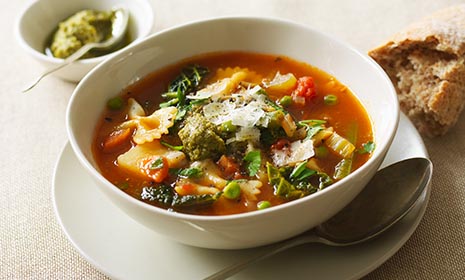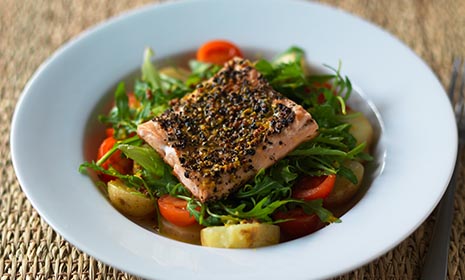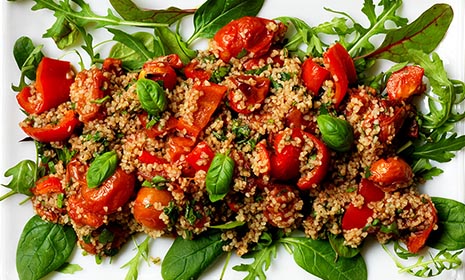Mediterranean diets have been associated with reduced risk of high blood pressure and cholesterol which are risk factors for heart disease. A Mediterranean style diet can therefore provide a great option for people with diabetes, as it could help reduce the risk of certain diabetes complications.
There’s also evidence to show that the Mediterranean-style diet can promote weight loss and improve blood glucose management in people with type 2 diabetes.
This is a diet largely based on plant foods and therefore includes a lot of fruits and vegetables, beans and pulses, nuts and seeds, wholegrains and olive oil. It also includes some dairy (milk and yogurts), lean protein like chicken, eggs and fish, in moderation. Red meat and processed foods are usually only consumed in much smaller amounts, and wine is included in moderation.
We’ve developed this simple Mediterranean plan to make it easier for you to follow this diet. It's both calorie and carb counted for your convenience, and contains at least five portions of fruit and veg per day.
We’ve included the values for fibre too to help you make sure you are meeting your nutritional requirements. We know lots of people in the UK aren’t eating enough fibre, so it’s important to try and include good sources in your diet every day.
Before you begin this meal plan
Before starting any healthy eating programme, please read how to choose your meal plan to make sure you follow the plan that's right for you.
Please speak to your diabetes health care team before making significant changes to your diet.
This is especially important if you treat your diabetes with insulin or other diabetes medications that increase the risk of hypos. Reducing your carbohydrate intake and changes to your body weight may mean your medication needs to be adjusted.
Important points about this meal plan
- This meal plan has taken nutritional information from our recipes and the sixth edition of Carbs and Cals, unless otherwise stated.
- A mix of whole milk and semi skimmed has been used, but please use whichever you prefer. Any dairy alternative should be unsweetened and fortified with calcium.
- These meal plans meet your recommended amount of fibre across the week.
- This meal plan outlines daily food intake for one person, but it’s still important to remember to drink regular fluids. This includes plain water, plain milk, and tea or coffee without added sugar.
Disclaimer: every effort has been taken to make these meal plans as accurate as possible, but there will be some variation in nutritional values. Speak to a dietitian or your diabetes healthcare team if you have questions about your individual dietary needs.
Your weekly Mediterranean meal plan
Please note that the full nutritional information and exact specifications for all meals and snacks is available in the Mediterranean meal plan (PDF, 86KB) only, and not listed below.
The weekly overview

Monday
Breakfast: Bircher muesli
Lunch: Hearty minestrone soup
Dinner: Grilled lemon and chilli chicken with couscous
Pudding: Full of fruit sundaes
Snacks: Greek yogurt, a peach, a medium banana, 30g plain almonds, 40g carrot sticks and 30g houmous
Milk: 225ml whole milk

Tuesday
Breakfast: 30g oat flakes with 125g Greek yogurt, 80g raspberries and 85g banana
Lunch: Salmon, red onion and sweet pepper wraps
Dinner: Cod Portugaise with boiled new potatoes and side salad
Pudding: Apple, blackberry, oat and seed crumble
Snacks: One apple and crunchy peanut butter, two oatcakes with cottage cheese and cucumber, one orange
Milk: 225ml semi-skimmed milk

Wednesday
Breakfast: Bircher muesli
Lunch: Hearty Spanish omelette with salad
Dinner: Galician stew with roasted butternut squash
Pudding: One medium banana
Snacks: Honeydew melon and Greek yogurt, plain almonds, oatcakes and houmous
Milk: 225ml whole milk

Thursday
Breakfast: Two slices of medium granary toast with crunchy peanut butter, and a banana
Lunch: Chickpea and tuna salad
Dinner: Greek style chicken pittas
Pudding: Blackcurrant and raspberry ice cream made with calcium fortified soya milk
Snacks: Warm exotic fruit salad with Greek yogurt, 50g cottage cheese with 80g cherry tomatoes and 30g pumpkin seeds, one orange
Milk: 225ml semi-skimmed milk

Friday
Breakfast: Very berry porridge
Lunch: Minted aubergine with spinach and pine nuts, paired with grilled chicken breast
Dinner: Crisp salmon salad
Pudding: Apple, blackberry, oat and seed crumble
Snacks: One peach, Greek yogurt with plain almonds, spicy roasted chickpeas
Milk: 225ml semi-skimmed milk

Saturday
Breakfast: Two poached eggs with rye bread and vegetable oil-based spread
Lunch: Roast mackerel with a curried coriander crust with baby new potatoes and broccoli
Dinner: Aubergine and courgette parmesan bake and peas
Pudding: Fruity chocolate tray bake
Snacks: 80g raspberries with Greek yogurt, two oatcakes with cottage cheese and cucumber, plain almonds
Milk: 225ml whole milk

Sunday
Breakfast: Oat flakes and Greek yogurt with raspberries and banana
Lunch: Hearty minestrone soup
Dinner: Greek homestyle chicken with Tomato, olive, asparagus and bean salad
Pudding: Warm exotic fruit salad with Greek yogurt
Snacks: Plain almonds, two satsumas, and a portion of spicy roasted chickpeas
Milk: 225ml semi-skimmed milk
Adapting this meal plan to suit you
Unless stated otherwise, each meal included in this plan is given per person. Our Mediterranean meal plan should be adjusted according to your needs, as everyone requires a slightly different amount of nutrients each day. For example, we don't all need to eat the same amount of calories. Men, who are generally heavier and have more muscle compared to women, need more calories.
Young children also need fewer calories than adults. But boys older than 11 and girls aged 15 and above are likely to need more calories. Children’s nutritional requirements change as they get older. So, adjust portion sizes accordingly to meet your family's needs and appetites.
You may need to adjust portion sizes for each member of your family as it is likely you won’t all eat the same portion size.
